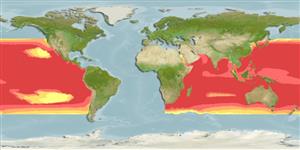Common names from other countries
分类 / Names
俗名 | 同种异名 | Catalog of Fishes(属, 种) | ITIS | CoL | WoRMS | Cloffa
Environment: milieu / climate zone / depth range / distribution range
生态学
海洋; 海洋洄游的 (Ref. 51243); 深度上下限 0 - 915 m (Ref. 43), usually 0 - 200 m (Ref. 43). 亞熱帶的; 15°C - 30°C (Ref. 43); 44°N - 47°S, 18°E - 69°W (Ref. 43)
Indo-Pacific: tropical and subtropical waters, occasionally entering temperate waters. Stray individuals migrate into the Atlantic Ocean by way of the Cape of Good Hope, but the existence of Atlantic breeding stocks is unlikely. Highly migratory species.
印度-太平洋: 熱帶與亞熱帶的水域, 偶然地進入溫帶的水域。 迷途的個體迴游進入大西洋之內經由好望角,但是大西洋繁殖分枝的生存不太可能。 高度遷移的種,1982年海事法會議的附件一.(參考文獻 26139)
大小 / 重量 / 年龄
Maturity: Lm ? range ? - ? cm
Max length : 465 cm FL 雄鱼/尚未辨别雌雄; (Ref. 40637); common length : 380 cm TL 雄鱼/尚未辨别雌雄; (Ref. 30573); 最大体重: 750.0 kg (Ref. 5503)
背棘 (总数) : 0; 背的软条 (总数) : 39 - 50; 臀棘: 0; 臀鳍软条: 16 - 21. Body elongate and not very compressed; upper jaw produced into a robust but not very long beak; two dorsal fins, the height of the first less then the greatest body depth, becoming shorter posteriorly; pectoral fins falcate and rigid, with 19 to 20 rays; body densely covered with small, embedded scales with 1 or 2 sharp points; back dark blue; belly silvery white; membrane of first dorsal fin blue black, without spots; flanks without spots (Ref. 55763). Dark blue above, silvery white below; sometimes with light blue vertical stripes; 1st dorsal fin blackish to dark blue, other fins dark brown with tinges of dark blue in some specimens.
细长的身体而不是非常扁长形的; 上颌伸展到结实但不伸展到非常长的喙了; 二个背鳍, 第一个的高度比较少量然后最大的体高, 在后部地变得比较短的; 胸鳍镰刀状而硬的, 藉由 19个到 20 鳍条; 身体浓密地覆盖着了小的, 埋入鳞片有 1 或 2 点尖; 背面深蓝色; 腹面银白色; 第一背鳍蓝色的黑色的薄膜, 没有斑点; 没有斑点的侧面.(参考文献 55763) 背面深蓝色的, 下面银白色的; 有时有浅蓝色垂直的斑纹; 第一背鳍黑色的对深蓝色, 其他的鳍深褐色的在一些标本中有深蓝色的淡色。
Oceanic, usually found in surface waters above the thermocline, often near shore close to land masses, islands and coral reefs. Feed on fishes, squids, cuttlefishes, octopods, large decapod crustaceans and mostly on small tunas when abundant (Ref. 9668). The flesh is of good quality; marketed refrigerated or frozen and prepared as sashimi in Japan (Ref. 9308). Also Ref. 9692.
大洋性的, 通常发现于在温水层上面的水表面, 时常近岸接近大陆区块,岛与珊瑚礁。 捕食鱼,乌贼,墨鱼,章鱼,大的十足目的甲壳动物与主要吃小鲔鱼当丰富的时候.(参考文献 9668) 肉是有好品质的; 在市场上销售在日本使或冷却冻结而且作为生鱼片。 (参考文献 9308) 也参考文献 9692.
Life cycle and mating behavior
Maturities | 繁殖 | Spawnings | Egg(s) | Fecundities | 仔鱼
Believed to prefer water temperatures around 27° to 28°C during spawning. Egg counts of ripe roe totaled about 40 million per female. 印度-太平洋: 熱帶與亞熱帶的水域, 偶然地進入溫帶的水域。 迷途的個體迴游進入大西洋之內經由好望角,但是大西洋繁殖分枝的生存不太可能。 高度遷移的種,1982年海事法會議的附件一.(參考文獻 26139)
Nakamura, I., 1985. FAO species catalogue. Vol. 5. Billfishes of the world. An annotated and illustrated catalogue of marlins, sailfishes, spearfishes and swordfishes known to date. FAO Fish. Synop. 125(5):65p. Rome: FAO. (Ref. 43)
CITES (Ref. 128078)
Not Evaluated
人类利用
渔业: 商业性; 游钓鱼种: 是的
工具
特别资料
下载 XML
网络资源
Estimates based on models
Preferred temperature (Ref.
115969): 16 - 28.4, mean 25.4 (based on 3272 cells).
Phylogenetic diversity index (Ref.
82804): PD
50 = 1.0005 [Uniqueness, from 0.5 = low to 2.0 = high].
Bayesian length-weight: a=0.00447 (0.00209 - 0.00953), b=3.13 (2.93 - 3.33), in cm Total Length, based on LWR estimates for this species & (Sub)family-body (Ref.
93245).
营养阶层 (Ref.
69278): 4.5 ±0.4 se; based on diet studies.
回复力 (Ref.
120179): 中等的, 族群倍增时间最少 1.4 - 4.4年 (K=0.47(?); Fec=67 million; assuming tm>2).
Prior r = 0.28, 95% CL = 0.19 - 0.42, Based on 2 full stock assessments.
Fishing Vulnerability (Ref.
59153): Very high vulnerability (78 of 100).
Climate Vulnerability (Ref.
125649): Very high vulnerability (76 of 100).
